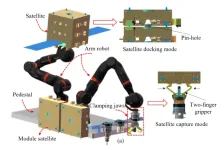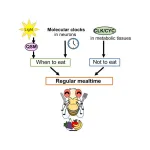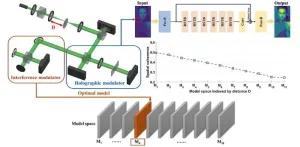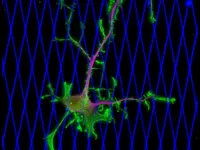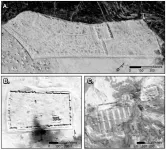(Press-News.org)
On-orbit assembly has become a crucial aspect of space operations, where the manipulator frequently and directly interacts with objects in a complex assembly process. The traditional manipulator control has limitations in adapting to diverse assembly tasks and is vulnerable to vibration, leading to assembly failure. To address this issue, Researchers at Beijing Institute of Technology propose a human-like variable admittance control method based on the variable damping characteristics of the human arm. This method can effectively increase the safety, robustness, and adaptability of robot space assembly. The team published their findings in Cyborg and Bionic Systems on September 6, 2023.
Robots are increasingly being used for maintenance and repair in space due to their greater adaptability to the harsh space environment compared to human astronauts. This trend is critical for the development of space technology, as it can help mitigate health risks for humans in space stations and address the challenges of repairing spacecraft in space. Robotic assembly is a vital field of research that has seen important progress in recent years. Compliance control has emerged as the primary method for enabling robots to perform complex assembly tasks. However, compliance control places high demands on the manipulator’s contact performance, making it challenging to achieve the required levels of precision and adaptability.
In response to these challenges, researchers have proposed various compliance control methods, including damping control, stiffness control, force/position hybrid control, and fuzzy adaptive control algorithms. These algorithms aim to improve the adaptability and efficiency of robots when performing assembly tasks, particularly in unknown environments.
Assembly tasks frequently involve contact between a manipulator and an object being assembled. To prevent excessive contact force from damaging the object, damping is necessary to dissipate energy and restrain vibration. Objects with larger damping consume energy more rapidly under external forces. The human arm’s musculoskeletal system can flexibly adjust damping to perform various tasks safely and stably. To collect parameters such as contact force and velocity, the team established a dynamic data acquisition platform to capture human arm motion. The system’s main components include a motion capture subsystem and a contact force measurement subsystem. An ATI omega160 6D force sensor is used to collect contact force data between the human hand and assembly parts, while end velocity data of the human arm are obtained using a Stereolabs ZED mini motion capture system. “In order to gain a more accurate understanding of the motion characteristics of human arms, we use high-performance equipment to measure and analyze the obtained data,” said Xiao Huang, a researcher at Beijing University of Technology.
In order for the robot to better complete the assembly task, the researchers summarized the dynamic characteristics of the human by analyzing the movement data of the human arm during the assembly process and they applied this feature to robots. In addition, because satellite assembly tasks are diverse and contact patterns are complex, the research team analyzed various scenarios during the satellite assembly process and summarized three contact patterns for satellite assembly. "This can help us better model contacts for robotic satellite assemblies and more accurately control the safe assembly of robots,"said Xiaolei Cao, a researcher at Beijing University of Technology.
With their experiment, the team conducted space satellite assembly simulation verification through a ground experimental platform. Their robotic platform is capable of measuring forces and torques at the end of a robotic arm in the X, Y, and Z directions. They applied the human-like variable parameter admittance controller to the robot satellite assembly experiment and successfully verified the effectiveness of the human-like variable parameter admittance controller.
Human-like control strategies can improve the adaptability, precision, and controllability of robots performing space assembly and maintenance tasks. However, further research is necessary to enable robots to accomplish flexible assembly tasks comparable to real humans. Durable and reliable robots capable of withstanding harsh space environments are also needed. “Advancements in humanoid control strategies can have important implications for the future of space exploration and development, further improving mission efficiency, safety, and reliability,” said Zhihong Jiang, a professor at Beijing University of Technology.
The research team includes Xiaolei Cao , Xiao Huang, Yan Zhao , Hui Li and Zhihong Jiang from Beijing University of Technology, Zeyuan Sun from China Northern Vehicle Research Institute, Beijing; and Marco Ceccarelli from Department of Industrial Engineering, University of Rome Tor Vergata, Via del Politecnico.
The research is supported by the National Natural Science Foundation of China (U22B2079, 62103054, U1913211, U2013602, and 62273049).
END
A groundbreaking scientific study conducted along the Southeast coast of India has unearthed a pressing environmental concern -the increasing risk of invasive species colonization on marine debris. The research, published recently in Marine Pollution Bulletin, delves into the critical interplay between plastic pollution and the introduction of non-indigenous organisms into Indian waters.
In recent years, the surge in anthropogenic litter in the ocean has provided an extensive array of substrates for marine ...
Tokyo, Japan – Researchers from Tokyo Metropolitan University have used fruit flies to study how daily eating patterns are regulated. They found that the quasimodo (qsm) gene helped sync feeding to light/dark cycles, but not in constant darkness: instead, the genes clock (clk) and cycle (cyc) keep eating/fasting cycles, while other “clocks” in nerve cells help sync it to days. Deciphering the molecular mechanism behind eating cycles helps us understand animal behavior, including our own.
Many members of the animal kingdom eat at roughly the same times each day. This is born out of the need to adapt to aspects of the environment, including ...
Experts in the Texas A&M University Department of Geography are teaming up with civil and chemical engineers and water resource, disaster recovery and public health researchers across the campus in a collaborative effort to better safeguard Texas Gulf Coast communities against climate-related emergencies, fueled by a three-year, $1.5 million grant from the National Academies Gulf Research Program (GRP).
The project, titled "Climate-LEAD: Climate Effects on Localized Environmental Health Disparities in Overburdened Texas Communities along Gulf Coast," is ...
Cedars-Sinai Cancer investigators have found that Black men respond as well as white men to systemic therapies for advanced prostate cancer when access to quality healthcare is equal, regardless of socioeconomic status. Their study, published today in the peer-reviewed Journal of Clinical Oncology, counters previous research suggesting that Black men receiving these therapies—which include hormone therapy, chemotherapy and immunotherapy—fare worse than white men do.
“We believe this is the most comprehensive look at this issue to date, and our findings suggest that, under the right conditions, Black men with metastatic ...
University of Maryland researchers studying how lithium batteries fail have developed a new technology that could enable next-generation electric vehicles (EVs) and other devices that are less prone to battery fires while increasing energy storage.
The innovative method, presented in a paper published Wednesday in the journal Nature, suppresses the growth of lithium dendrites—damaging branch-like structures that develop inside so-called all-solid-state lithium batteries, preventing firms from broadly commercializing the promising technology. But this new design for a battery “interlayer,” led by Department of Chemical and Biomolecular Engineering ...
Holographic imaging has always been challenged by unpredictable distortions in dynamic environments. Traditional deep learning methods often struggle to adapt to diverse scenes due to their reliance on specific data conditions.
To tackle this problem, researchers at Zhejiang University delved into the intersection of optics and deep learning, uncovering the key role of physical priors in ensuring the alignment of data and pre-trained models. They explored the impact of spatial coherence and turbulence on holographic ...
DALLAS, October 27, 2023 — Approximately 50 million people in the United States are at higher risk for heart disease and/or stroke because they lack the most basic needs — healthy food, clean air and drinking water, quality education, employment, housing and access to health care. Historically, people of color -- including Black and Hispanic/Latino people, are at even higher risk of cardiovascular disease (CVD) for these same reasons. Through the American Heart Association’s 2023 EmPOWERED to Serve Business Accelerator™, three local social entrepreneurs ...
UNIVERSITY PARK, Pa. — The most lethal feature of any cancer is metastasis, the spread of cancer cells throughout the body. New research led by Penn State reveals for the first time the mechanics behind how breast cancer cells may invade healthy tissues. The discovery, showing that a motor protein called dynein powers the movement of cancer cells in soft tissue models, offers new clinical targets against metastasis and has the potential to fundamentally change how cancer is treated.
“This discovery marks a paradigm shift in many ways,” said Erdem Tabdanov, assistant professor of pharmacology at Penn State and a lead co-corresponding author on the study, recently published ...
Two-thousand years ago, forts were constructed by the Roman Empire across the northern Fertile Crescent, spanning from what is now western Syria to northwestern Iraq.
In the 1920s, 116 forts were documented in the region by Father Antoine Poidebard, who conducted one of the world's first aerial surveys using a WWI-era biplane. Poidebard reported that the forts were constructed from north to south to establish an eastern boundary of the Roman Empire.
A new Dartmouth study analyzing declassified Cold War satellite ...
JMIR Neurotechnology, published by JMIR Publications, welcomes submissions from researchers, clinicians, caregivers, and technologists that explore novel diagnostic and treatment tools for neurological disorders, particularly those leveraging the potential of neurotechnology.
The scope of the journal includes but is not limited to:
Neuroradiology
Advancements in neurosurgery
Innovative diagnostic tools and techniques
Cutting-edge neurotechnology for therapeutics
Data sharing and open science in neurotechnology
Code ...
